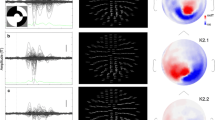Summary
The Global Field Power measurement (GFPM) was proposed as a method for the determination of component latency in multichannel evoked potential (EP) recordings (Lehmann and Skrandies 1980). In contrast to the classical method (CM) of peak latency determination using only two or three electrodes, multichannel recordings deal with data from twenty or more recording electrodes. We compared the GFPM and CM in evoked potential recordings. Sixty five subjects volunteered for 3 different response tasks. In a P3 oddball paradigm targets consisted of 2000 Hz tonebursts, nontargets of 1000 Hz tonebursts. Flash and Pattern Visual Evoked Potentials (VEP) also were recorded. At peak GFPM latency we found steeper voltage gradients than at CM latency. Both N200 and P300 had a significantly different topography at latencies determined by GFPM than at latencies determined by CM. For VEP we did not find a significant difference between CM and GFPM. Our Data suggests that multichannel recording adds additional dimensions to EP measurements and that only GFPM leads to an unbiased data-reduction as it determinesone momentary map in time which has maximal field strength.
Similar content being viewed by others
References
Van der Burgt, M. and Hamburger, H. Classical Method versus Global Field Power in the determination of "the latency" of evoked potentials. Brain Topography, 1988, 1: 145–146.
Lehmann, D. and Skrandies, W. Reference-free identification of components of checkerboard-evoked multichannel potential fields. Electroenceph. Clin. Neurophysiol., 1980, 48: 609–621.
Lehmann, D. and Skrandies, W. Spatial analysis of evoked potentials in man - a review. Progress in Neurobiology, 1984, 23: 227–250.
Lehmann, D. Spatial Analysis of EEG and Evoked Potential Data. In: F. Duffy (Ed.), Topographic Mapping of Brain Electrical Activity. Buttersworth Publishers, Massachusetts, 1986: 29–61.
Author information
Authors and Affiliations
Additional information
Acknowledgments: The authors wish to thank Prof. D. Lehmann, University Hospital, Zurich for scrutinizing the text and for his useful comments and Dr. C. Michel for his computer program to calculate and plot G.F.P.
Rights and permissions
About this article
Cite this article
Hamburger, H.L., v.d. Burgt, M.A.G. Global Field Power measurement versus classical method in the determination of the latency of evoked potential components. Brain Topogr 3, 391–396 (1991). https://doi.org/10.1007/BF01129642
Accepted:
Issue Date:
DOI: https://doi.org/10.1007/BF01129642




